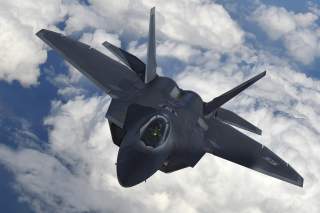Here's How The Deadly F-22 Got A Little Deadlier
Watch out!
Key Point: A fighter jet is nothing without its ordinance.
The Air Force and Lockheed Martin have now “validated” several new weapons on the F-22 Raptor to equip the stealth fighter with more long-range precision attack technology, a wider targeting envelope or “field of regard” and new networking technology enabling improved, real-time “collaborative targeting” between aircraft.
The two new weapons, which have been under testing and development for several years now, are advanced variants of existing weapons - the AIM-9X air-to-air missile and the AIM 120-D. Upgraded variants of each are slated to be operational by as soon as next year.
(This article first appeared in October 2018.)
The new AIM-9X will shoot farther and reach a much larger targeting envelope for pilots. Working with a variety of helmets and display systems, Lockheed developers have added “off-boresight” targeting ability enabling pilots to attack enemies from a wide range of new angles.
“It is a much more agile missile with an improved seeker and a better field of regard. You can shoot over your shoulder. If enemies get behind me in a close-in fight, I have the right targeting on the plane to shoot them,” Ken Merchant, Vice President, F-22, Lockheed, told Warrior Maven in an interview.
Another part of the weapons upgrade includes engineering the F-22 to fire the AIM-120D, a beyond visual range Advanced Medium-Range Air-to-Air Missile (AMRAAM), designed for all weather day-and-night attacks; it is a "fire and forget" missile with active transmit radar guidance, Raytheon data states.
The AIM-120D is built with upgrades to previous AMRAAM missiles by increasing attack range, GPS navigation, inertial measurement units and a two-way data link, Raytheon statements explain.
“The new AIM-120D uses a better seeker and is more maneuverable with better countermeasures,” Merchant said.
As the Air Force and Lockheed Martin move forward with weapons envelope expansions and enhancements for the F-22, there is of course a commensurate need to upgrade software and its on-board sensors to adjust to emerging future threats, industry developers explained. Ultimately, this effort will lead the Air Force to draft up requirements for new F-22 sensors.
F-22 lethality is also getting vastly improved through integration of new two-way LINK 16 data link connectivity between aircraft, something which will help expedite real-time airborne “collaborative targeting.”
“We have had LINK 16 receive, but we have not been able to share what is on the Raptor digitally. We have been doing it all through voice,” Merchant explained.
Having a digital ability to transmit fast-changing, combat relevant targeting information from an F-22 cockpit - without needing voice radios - lessens the risk associated with more “jammable” or “hackable” communications.
F-22 Technologies
Newer F-22s have a technology called Synthetic Aperture Radar, or SAR, which uses electromagnetic signals or “pings” to deliver a picture or rendering of the terrain below, allowing better target identification.
The SAR technology sends a ping to the ground and then analyzes the return signal to calculate the contours, distance and characteristics of the ground below.
The F-22 is also known for its “super cruise” technology which enables the fighter to reach speeds of Mach 1.5 without needing to turn on its after burners. This enables the fighter to travel faster and farther on less fuel, a scenario which expands its time for combat missions.
The fighter jet fires a 20mm cannon and has the ability to carry and fire all the air-to-air and air-to-ground weapons including precision-guided ground bombs, such Joint Direct Attack Munitions called the GBU 32 and GBU 39.
It also uses what’s called a radar-warning receiver – a technology with an updateable database called “mission data files” designed to recognize a wide-range of enemy fighters, much like the F-35.
Made by Lockheed Martin and Boeing, the F-22 uses two Pratt & Whitney F119-PW-100 turbofan engines with afterburners and two-dimensional thrust vectoring nozzles, an Air Force statement said. It is 16-feet tall, 62-feet long and weighs 43,340 pounds. Its maximum take-off weight is 83,500.
The aircraft was first introduced in December of 2005; the F-22 Raptor fighter jet delivered some of the first strikes in the U.S.-led attacks on the Islamic State in Iraq and Syria, when aerial bombing began in 2014, service officials told Warrior.
After delivering some of the first strikes in the U.S. Coalition-led military action against ISIS, the F-22 began to shift its focus from an air-dominance mission to one more focused on supporting attacks on the ground.
For the long term, given that the Air Force plans to fly the F-22 well into the 2060s, these weapons upgrades are engineered to build the technical foundation needed to help integrate a new generation of air-to-air missiles as they emerge in coming years.
“Our intent is to make sure we keep our first look, first shot, first kill mantra,” Merchant said.
Kris Osborn became the Managing Editor of Warrior Maven in August of 2015 . Osborn previously served at the Pentagon as a Highly Qualified Expert with the Office of the Assistant Secretary of the Army - Acquisition, Logistics & Technology. Osborn has also worked as an anchor and on-air military specialist at national cable networks.
This article first appeared in Warrior Maven here. It is being republished due to reader interest.
Image: Reuters.

